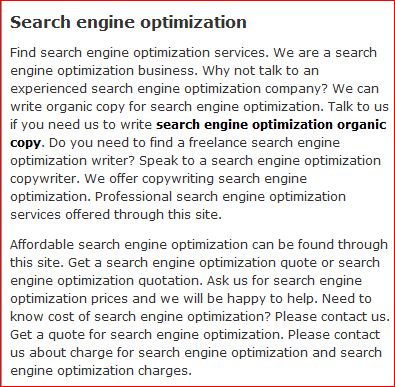Entries Tagged 'copywriting tips' ↓
November 4th, 2011 — copywriter, copywriting tips, effective copy
Can you really tell whether copy is good or bad just by looking at it?
The answer is yes and no.
It rather depends on what the copy is, what it’s meant to do and what form it takes.
For example if it’s SEO copywriting and it’s very obvious what the targeted keyword is, like in the example below…

…then it’s pretty safe to say it’s bad copy.
The problem is a section of text can be very well written (grammatically correct and no spelling errors) and yet, from a sales perspective, it’s about as useful as a chocolate teapot.
That’s why it’s not always easy to spot bad copy.
It’s probably easier to look at this from a different angle and think about what makes good copy.
The traits of good copy
Luckily there are 5 characteristics that good copy has. No matter which format it’s written for or what it’s trying to sell, good copy will always:
- Grab the readers’ attention immediately
- Be clear and unambiguous
- Answer all the readers’ questions and so counter any buying objections they may have
- Build trust and rapport with the reader
- Motivate the reader into taking a specific action through a strong call to action
What it comes down to is this – copy is written for a purpose (generally to sell something) but if it doesn’t fulfil that purpose it’s not doing its job.
Selling through text alone is difficult. You don’t have the personal contact with the customer; you can’t think on your feet to counter their buying objections and you can’t shake their hands.
Your copywriting has to do every thing:
- Inform
- Build trust
- Convince
- Convert into a sale
That’s not an easy thing to achieve.
What are your thoughts? Can you think of any more traits you find in good copy? Why not share them here along with any shocking examples of copy you’ve come across.
October 31st, 2011 — copywriter, copywriting tips, freelance copywriter, Interview techniques
 This is a guest post written by Tom Albrighton, a freelance copywriter and founder of ABC Copywriting. He writes regularly on copywriting issues for the ABC Copywriting blog.
This is a guest post written by Tom Albrighton, a freelance copywriter and founder of ABC Copywriting. He writes regularly on copywriting issues for the ABC Copywriting blog.
Of all the ways to obtain source material for your copywriting, interviewing must be one of the easiest and most productive. A half-hour phone chat or meeting with a client can easily generate enough material to write a thousand-word brochure, or develop a really strong tagline. But you have to do it right – so here are a few tips for getting the most out of interviews.
Preparation
It’s always worth writing a set of questions in advance. Even if you end up wandering way off topic, they’ll provide a useful structure to your interview and help you remember the points you want to cover.
Interviewees are reassured when you send them questions in advance, particularly if they’ve never been interviewed before. They can also spend some time thinking about their answers, or getting hold of data to back them up. (In my experience, material promised during the interview itself often fails to turn up, obliging you to chase your interviewee, which is awkward.)
Kit
Give yourself the best possible chance of hearing every nuance of your interview by investing in some decent recording kit.
For in-person interviews, I use a good-quality tape recorder. It’s not advanced but it gets the job done, and I like the reassurance of seeing the reels revolving. You might prefer to use an electronic recorder – certainly, having the interview as an MP3 is handy.
For phone interviews, I use a device called the THAT-2, which is connected between the handset and the phone (so you need a phone with a plug-in handset). You can connect it either to a tape recorder or to your computer, where you can record with an application like Audacity.
For quick and easy transcription of MP3s with iTunes on the Mac, use something like Sizzlin’ Keys, which lets you play, pause and skip backwards and forwards using keystrokes. Personally, I always use headphones, to get as close as possible to the original experience.
Questions
For copywriters, interviews are about exposition, not inquisition. You’re looking to get your interviewee to open up and give you everything they’ve got.
To achieve that, ask open questions, which typically begin with either ‘what’ or ‘how’. For example, ‘what does this product do?’ or ‘how will this service benefit customers?’
Listening
In person, it’s important to physically signal your interest by making eye contact, leaning forward attentively, nodding and so on. But that doesn’t work on the phone, so it’s worth making little affirmatory interjections like ‘mm’, ‘yeah’, ‘uh-huh’. ‘sure’, ‘right’ or whatever works for you, so the interviewee knows you’re still listening.
Don’t be afraid to ask for more information if you need it. Many interviewees feel self-conscious when talking for a long period, particularly if they are natural introverts. Reassure them that you’re still interested by saying ‘Can you tell me a little more about that?’ or something similar.
Make sure everything you say is oriented towards getting the interviewee to express themselves, rather than impressing them with your knowledge. Even the cleverest observations must be suppressed – this isn’t about you.
Reflecting
Sometimes, people get hung up on making a particular point that’s very important to them. Signals include rephrasing it again and again, or using more than one example to explain it. To show them you’ve understood, rephrase the point and say it back to them, starting with something like ‘So as I understand it, what you’re saying is…’
I also find this a very useful way to capture potentially useful phrases that come to me while people are speaking – for example, metaphors that might liven up the finished copy. By throwing them into the conversation, you make sure they’re in your recording.
Digressions
Sometimes, interviewees ramble badly, leaving your intended topic far behind. This can be frustrating, but you just have to wait for your chance to gently guide the conversation back on course.
The classic problem for copywriters is getting the client to think about customer benefits rather than the features of the product or service they’ve created. But sometimes, people just have to get all that feature stuff out of their heads before they can translate it into benefits – so give them some room.
Only interrupt the interviewee as a last resort – if you’re running out of time, say, and don’t have what you need. If you talk over them by mistake, say ‘sorry, go on’ and let them have the floor.
Wrapping up
Always thank the interviewee for their time and, if appropriate, give them the opportunity to review and approve what you write. Some people will ask for this up front, as a condition of being interviewed. In my experience, 95% of people will rubberstamp what you write. But be prepared for the exception who takes the opportunity to rewrite the whole thing – badly.
Transcription
When you transcribe, don’t be afraid to either (a) use the interviewee’s words verbatim or (b) chuck them out and use your own. People sometimes use the perfect phrase in conversation, but would never write it down – your job is to give them the authority to use it. Conversely, people’s own pet phrases might be completely inappropriate for the task at hand – but, after all, that’s your job!
October 26th, 2011 — b2b copywriter, b2c copywriter, copywriter, copywriting, copywriting tips
 As a copywriter, I get asked to write all manner of things. One day I could be writing about Risk and the financial markets, the next it could be cosmetic surgery, recruitment and architectural rendering.
As a copywriter, I get asked to write all manner of things. One day I could be writing about Risk and the financial markets, the next it could be cosmetic surgery, recruitment and architectural rendering.
But one thing always makes me smile, and that’s when I get emails asking for my B2B (Business to Business selling) experience.
Why does that make me smile?
Mainly because, in my view, B2B and B2C (Business to consumer) copywriting is one and the same.
[Gasp!]
Why do I think that? Let me explain.
B2B and B2C are the same
The aim of copywriting, regardless of whether you are working in a B2B or B2C market, is the same – to sell.
So there is the first amazing revelation dealt with.
The next is that, even though you’re writing for a B2B market, you are still trying to sell to a person. Don’t believe me? OK, answer these questions:
- Can a company physically buy something from you?
- Can a company meet you for a coffee whilst you talk business?
- Can a company sign that all important contract to confirm your sale?
I think you’ll find the answer to all of those questions is a big fat, resounding NO.
It all boils down to the fact that your copy has to convince a person within the company; therefore you are selling to a person. And as such, the copy you write is no different to if you were selling direct to the public.
Granted, your benefits will be orientated towards what’s in it for the business as opposed to the person you’re speaking (mind you, assuming your product is going to make the business more profitable, he/she will have a vested interest as it may well lead to a whopping bonus for them).
So, just as if you were writing to a consumer audience, your copy should be:
- Brief – you are writing to people at work so they will be time limited.
- Human, because business people are – they also make decisions partially for personal reasons (as mentioned above) so tap into reason and emotion for the best results.
- Full of benefits – buy this and you’ll save money, save time, make bigger profits, reduce staff turnover, and improve productivity…
In my humble opinion, all you have to do is keep it plain and simple, avoid clichés and, whatever you do, do not let any jargon slip into your copy.
Over to you
You’ve allowed me to rant on, but what do you think?
Do you agree that, essentially, copy should be the same regardless of whether it’s for a B2B or B2C market? Or do you think there are legitimate differences between the two?
Leave a comment below, I’d love to hear you take on this one.
October 24th, 2011 — copywriter, copywriting tips, marketing, SEO copywriter, seo website copywriter
 Have you noticed how different ideas spring up from time to time?
Have you noticed how different ideas spring up from time to time?
It’s the same in the marketing world. Every now and then someone comes up with, what appears to be, a brilliant idea. Every one jumps on the bandwagon, only to discover after a few months or a year that it doesn’t actually work at all.
It’s the same in copywriting. Take SEO copywriting as an example. At the outset, marketers would go to great pains to tell you that your copy had to contain a certain percentage of your keywords. The fact that this stipulation usually resulted in complete gibberish, didn’t seem to matter.
“It’s what the search engines want”
And like good little marketers we all followed suit and merrily stuffed our copy with keywords. Finally, people have seen sense and realised that good SEO copy is written for the reader – it should be:
- Interesting
- Relevant
- Of simple construction
- Contain loads of subheadings and bulleted lists
- …oh, and the odd keyword.
Basically, if you want your copy to work (regardless of its use), just follow the copywriting ‘rules’ that have stood the test of time.
Copywriting hints set in stone
1. Sell
You are writing copy for one reason, and one reason only – to sell.
Simply describing a product or service won’t convince anyone to buy it. So forget your flowery, adjective-laden text, make every word count and every word sell.
2. Formula
Don’t try to reinvent the wheel. Always use a tried and tested copywriting formula you know works:
- Understand your objective
- Clarify the main benefits
- Show how those benefits are delivered and how they will have a positive effect on your customer
- Back up your claims with evidence (testimonials, test results etc.)
- Sprinkle with sugar – make a time limited offer or give something free that will be of value to your customer
- Tell them to buy in your call to action
3. Command
If you write waffle that’s very wishy-washy, no one’s going to take you, or your product, seriously. Be forthright in your language.
Don’t ask them to…
“Call us, you know, if you have time, we don’t want to put you out.”
Tell them…
“Call now and make sure you don’t miss out on the offer of a lifetime.”
4. Clear benefits
It is the benefits of your product that will sell it. By benefits, I mean what it will do for your customer. It could save them money, streamline their business processes, or make them more attractive…
Try and stick to the primary benefit in your copy – the one that will really make a difference to them – make sure you tell them enough to make them say ‘yes’ and use it in your headline.
5. Offer
Whatever your offer is, make sure it’s a strong one that your customers will want.
6. Guarantee
Everyone loves peace of mind, so offering a guarantee will encourage your reader to trust you enough to buy from you.
7. Respond now!
Your strong call to action (mentioned in number 3) will tell your reader what you want them to do, but you have to give them a reason.
Making a limited offer will create a sense of urgency and force them to make a buying decision. It might be that the price is only held for 30 days, there is a limited number of your product available or they’ll receive a free gift if bought before a certain date.
8. Make it easy
If you want your reader to order from you, don’t make them jump through hoops.
You want to create as simple a process as possible, otherwise they won’t bother.
9. Free
Yes, using the word ‘free’ does work. People love to get something for nothing; it’s definitely a hot word worth using.
Over to you
These copywriting hints have served marketers well over the years, but the list is by no means exhaustive.
Can you add to it? If so, leave a comment below and let’s see how many tips we can come up with.
October 21st, 2011 — copywriter, copywriting, copywriting tips, Customer service, freelance copywriter
Although this is being written from a copywriter’s point of view, what follows applies equally to all professions.
As my mum always used to say to me…
“Treat others as you would like to be treated.”
And she wasn’t wrong (not with that piece of advice anyway).
Rather than go into reams of text arguing my point, below are a few simple things you can do to add value to your relationships with your clients:
1. Listen
Simple and yet often over looked.
The only way you will fully understand the project is by being attentive, taking notes and asking loads of questions to clarify precisely what is required.
Never try to guess at what your client wants. If you don’t understand or the brief is unclear, ask for clarification. They’d much rather you did that than submit work that is completely wrong.
2. Ask what they want
As a professional writer, never be tempted to take a brief and then write what you think they should have.
Ask what they are looking to achieve with the project and how they want to be perceived by their readers. If you can see an obvious disconnect, talk it through with them and suggest an alternative plan.
3. Promises, promises
Yes, you are going to want to promise your new client the earth. But promising unrealistic deadlines or outcomes will only lead to disappointment.
When agreeing a deadline, make sure it’s achievable.
4. Update regularly
Writing is a solitary profession, but that doesn’t mean you can cut yourself off completely.
Regular contact (email or phone) will keep your client in the loop so they know exactly what’s happening and what stage you are at with the project.
There’s nothing more frustrating than hiring someone to do a job for you who you then don’t hear from for weeks.
5. Contactability
Ok, that’s not actually a word, but it should be.
If your client can’t get hold of you easily, you are going to seriously hack them off.
Granted, you’re not going to be able to answer your phone every second of the day and you are allowed a few breaks, but if they leave a message, phone them back. If they send you an email, reply to them within an hour or two (if possible).
By giving them various contact options such as phone (landline and mobile), email and Skype, you are making yourself accessible.
6. It was me
Things do go wrong – yes, even to you.
No one is perfect, so if you make a mistake, own up to it. If you try to bluff your way out of a bad situation, you’ll only make it worse.
Your client will think more of you if you say “Yes, I made a mistake” and then put it right.
7. Thank you
They may be two small words, but they are very powerful.
It doesn’t take a lot to thank them for their business, so make sure you do.
Over to you
Do you have any little tricks you use to keep your clients happy?
Leave a comment below and let’s see how many different ways we can come up with.










